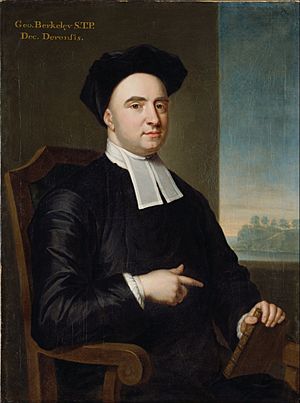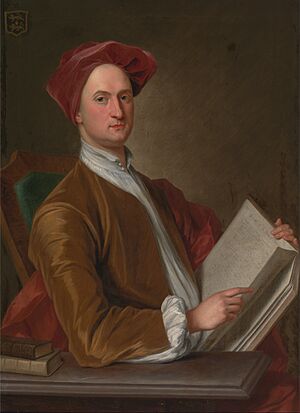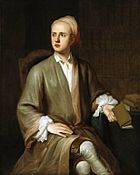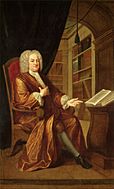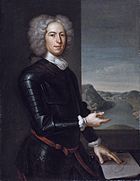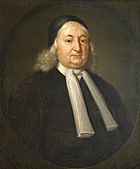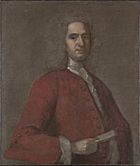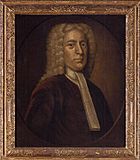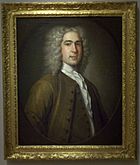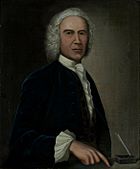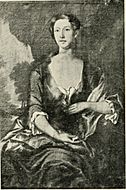John Smibert facts for kids
Quick facts for kids
John Smibert
|
|
|---|---|
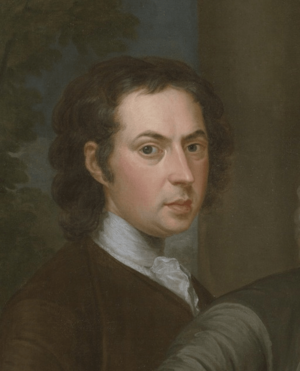
Self-portrait of Smibert, present as part of The Bermuda Group, c. 1729–1731, Yale University Art Gallery
|
|
| Born | 24 March 1688 |
| Died | 2 April 1751 (aged 63) |
| Nationality | Scottish American |
| Education | Godfrey Kneller |
| Known for | Portrait painting |
|
Notable work
|
The Bermuda Group, c. 1728–1731 |
John Smibert (sometimes spelled Smybert; born March 24, 1688 – died April 2, 1751) was a painter from Scotland. He is known as the first artist with formal training to live and work regularly in British America. He painted many important people during his time.
Contents
Smibert's Life and Art Career
Early Life and Training
John Smibert was born in Edinburgh, Scotland, on March 24, 1688. He was one of six children. His father, John Smibert, was a "litster," which means he dyed wool.
From 1702 to 1709, John Smibert trained as a house painter and plasterer in Edinburgh. In 1709, he moved to London. There, he worked painting coaches and copying other artworks.
Between 1713 and 1716, he studied art under a famous painter named Godfrey Kneller. This training happened at the Great Queen Street Academy. After his studies, Smibert returned to Edinburgh to find work as a portrait painter.
From 1719 to 1722, Smibert traveled to Italy. He went there to copy paintings by old master artists. After this trip, he lived in London and worked as a portrait painter until 1728.
Smibert was also part of a group called the Rose and Crown Club. He even sketched a group portrait of its members. This sketch included other artists like George Vertue and John Wootton.
Journey to America
In 1728, a man named George Berkeley, who was a bishop, convinced Smibert to go to America. Bishop Berkeley planned to start a college in Bermuda and wanted Smibert to teach fine arts there.
However, the college was never built. So, Smibert decided to settle in Boston, Massachusetts. He got married in Boston in 1730. He lived at the corner of Brattle Street and Queen Street. He also joined the Scots Charitable Society of Boston.
Famous Paintings
In 1728, Smibert began painting Dean George Berkeley and His Entourage. This painting is also known as The Bermuda Group. It became one of the most important portraits in New England.
A man named John Wainright asked Smibert to paint it. The painting shows the people who were going to be part of the Bermuda expedition. Today, you can see this painting at the Yale University Art Gallery. It shows Bishop Berkeley on the right, Wainright sitting on the left, and Smibert himself standing on the far left.
Smibert painted many other important people. These include Jonathan Edwards and Judge Edmund Quincy. You can find Quincy's portrait at the Museum of Fine Arts, Boston. He also painted Mrs. Smibert, Peter Faneuil, and Governor John Endecott. Many of his works are owned by universities like Harvard and Yale.
Smibert's Art Shop
In 1734, Smibert opened a shop. He sold paint, other art supplies, and prints there. Above his shop, he had a studio where he showed off copies of old master paintings he had made in Europe.
This collection was like "America's first art gallery." It helped teach many young artists, including Charles Willson Peale, Gilbert Stuart, and John Trumbull. They learned a lot by studying Smibert's collection.
Designing Faneuil Hall
Between 1740 and 1742, Smibert also worked as an architect. He designed the first Faneuil Hall in Boston. He designed it to look like an English country market.
The original hall burned down in 1761. However, it was rebuilt and later made much larger by Charles Bulfinch in 1806.
Smibert's son, Nathaniel Smibert, also became a painter. John Smibert is buried in Tomb 62 at the Granary Burying Ground in Boston.
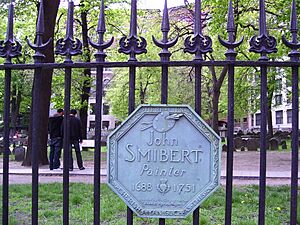
Selected Works
-
Benjamin Morland, painted in 1724. Now at the Yale Center for British Art.
-
Elizabeth Davenport (Mrs. William Dudley), painted in 1729. At the Museum of Fine Arts, Boston.
-
Samuel Sewall, painted in 1729. At the Museum of Fine Arts, Boston.
-
Francis Brinley, around 1729. At the Metropolitan Museum of Art.
-
Portrait of Edmund Quincy. At the Museum of Fine Arts, Boston.
-
1730 portrait of Thomas Hancock. At the Museum of Fine Arts, Boston.
-
Malachy Salter, at Province House (Nova Scotia).
-
Catherine Winthrop Sargent, painted by Smibert. She married Col. Epes Sargent (soldier) in 1744. This portrait is at the Museum of Fine Arts, Boston.


